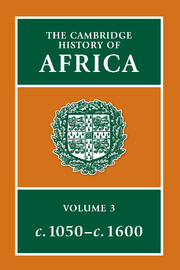Book contents
- Frontmatter
- Introduction: some interregional themes
- 1 Egypt, Nubia and the Eastern Deserts
- 2 Ethiopia, the Red Sea and the Horn
- 3 The East Coast, Madagascar and the Indian Ocean
- 4 The eastern Maghrib and the central Sudan
- 5 The western Maghrib and Sudan
- 6 Upper and Lower Guinea
- 7 Central Africa from Cameroun to the Zambezi
- 8 Southern Africa
- 9 The East African interior
- Bibliographical Essays
- Bibliography
- Index
- References
7 - Central Africa from Cameroun to the Zambezi
Published online by Cambridge University Press: 28 March 2008
- Frontmatter
- Introduction: some interregional themes
- 1 Egypt, Nubia and the Eastern Deserts
- 2 Ethiopia, the Red Sea and the Horn
- 3 The East Coast, Madagascar and the Indian Ocean
- 4 The eastern Maghrib and the central Sudan
- 5 The western Maghrib and Sudan
- 6 Upper and Lower Guinea
- 7 Central Africa from Cameroun to the Zambezi
- 8 Southern Africa
- 9 The East African interior
- Bibliographical Essays
- Bibliography
- Index
- References
Summary
The history of Central Africa between AD 1000 and 1600 can be broadly divided into three parts on the basis of the historical evidence so far available. In the south-east the territory of Zambia is primarily known in this period through archaeological research. The main theme is the transition from Early Iron Age cultures to Later Iron Age cultures. This transition concerned the spread of more advanced technologies, the evolution of new pottery styles, and the exchange of rare commodities over increasingly long distances. The second region, in the savannas of south-western Zaïre and Angola, saw the emergence in the late medieval period of several important political leaders. Their exploits have been recorded in oral evidence which can be supplemented, in the sixteenth century, by the writings of early European visitors to the region. Finally, the third and largest part of Central Africa covers the equatorial forest and the woodland margin to the north of it. Here historical evidence is extremely sparse, and historical speculation depends largely on ethnographic and linguistic data. The results are so far unsatisfactory, but further work should gradually enable us to understand the two main themes of the history of the north. One is the interaction between forest cultures and savanna cultures both north and south of the equator. The other is the changing relationships between gathering and farming peoples within the forest.
- Type
- Chapter
- Information
- The Cambridge History of Africa , pp. 519 - 566Publisher: Cambridge University PressPrint publication year: 1977
References
- 2
- Cited by



